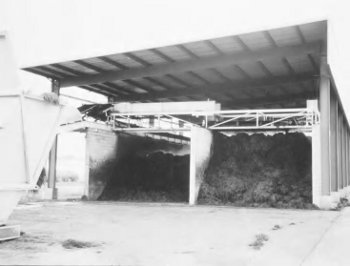Aerated Phase I Composting
Improving community relations has led to alterations in the way the Phase I mushroom composting process is carried out. As urban areas encroach on rural farmland, residents have made odor-related complaints and legal battles have ensued, which suggest a need for more stringent odor-management practices.
If the pile is not turned and aerated during Phase I composting, oxygen may become limited and anaerobic conditions may develop along the
bottom of the stack. As the anaerobic core gets larger, more offensive odors are produced. In order to maintain aerobic conditions throughout the entire substrate pile, supplemental aeration is sometimes used. This aeration is accomplished by using a fan to force air up through a concrete pad with a series of evenly distributed openings and into the substrate material. This design is referred to as an aerated floor. Systems have been built with structural sidewalls, usually of concrete and occasionally of wood, to form the piles with a uniform height and depth (Figure 4). Aside from aerated floors and structural sidewalls, there is great variation among bunker systems currently being used for Phase I.

Figure 4. This aerated substrate preparation system has a piped concrete floor
under the substrate that forces air through the substrate to maintain aerobic
conditions during the composting process.
Aerated composting systems are replacing conventional ricks throughout Europe and are beginning to gain acceptance in North America as the quest to manage odors continues. Europeans were the first to regulate emissions from their agricultural operations. Therefore, most European mushroom composting operations have employed some type of enclosed or environmentally controlled Phase I system. In North America, a few systems have been built to test the technology. Eventually they may become common at commercial operations. Unfortunately, little information is available to show how these systems reduce emissions. Therefore, determining how effective aerated systems are in reducing odors is difficult.
Phase I is considered complete as soon as the raw ingredients become pliable and are capable of holding water, the odor of ammonia is sharp, and the dark-brown color indicates that carmelization and browning reactions have occurred. At the beginning of Phase I, the substrate is bulky and yellow. At the end of Phase I substrate preparation, the substrate should be dense, chocolate brown in color, and have a strong odor of ammonia. The substrate still has some structure so aeration can be maintained during Phase II composting. The potential fresh mushroom yield depends on the amount of dry weight filled. In order to achieve a substrate density in the growing structure necessary to support an economical mushroom yield, the substrate at fill has to be short or dense enough to attain a high substrate dry weight.
6119 view.